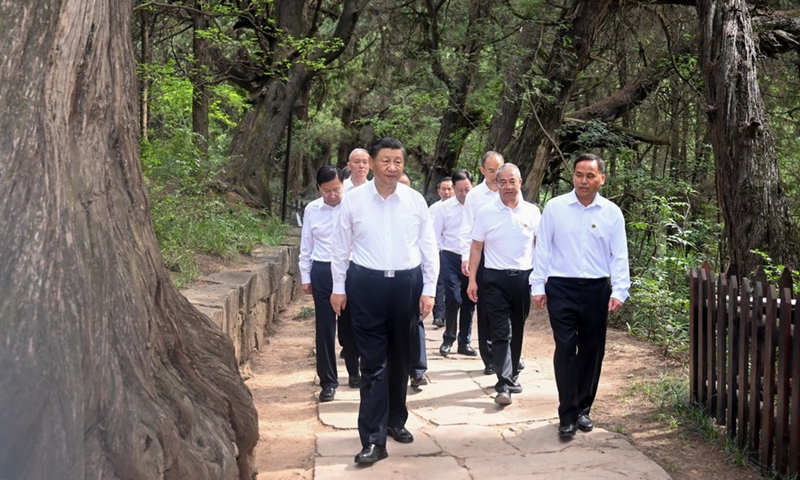Country’s actions ‘global bellwether’ on global ecological protection
President Xi Jinping visited the site of a section of an ancient road system known as “Shudao” in Guangyuan; which winds its way through rugged mountains and ancient trees. There, Xi learned about efforts surrounding ecological conservation.
This visit marks Xi’s attention on China’s ecological development, which has achieved remarkable progress over the past 10 years, said experts. Witnessing the government’s recent remarks on ecology, they believed that the country’s road of building a Beautiful China has demonstrated the nation’s wisdom in balancing the needs of economic development and improving the environment.
Before heading to Sichuan, Xi, who is also general secretary of the Communist Party of China Central Committee and chairman of the Central Military Commission, delivered a speech at a national conference on ecological and environmental protection held from July 17 to 18.
Xi said that the country’s ecological conservation has undergone a historic, transformative and comprehensive changes both in theory and practice, with significant strides made in building a Beautiful China.
Noting that China’s economy and society have entered a stage of high-quality development marked by accelerated progress in promoting green and low-carbon growth, Xi called for higher standards, a broader perspective and stronger efforts in planning and advancing ecological and environmental protection on the new journey, as well as writing a new chapter of ecological conservation in the new era.
Xi stressed the need to properly handle the relationships between high-quality development and high-level protection, between tackling major challenges and coordinating governance, between natural recovery and human-assisted restoration, between external constraints and internal driving forces, as well as between “dual carbon” commitments and self-determined actions.
Xi said that the country’s ecological conservation has undergone historical, transformative and comprehensive changes both in theory and practice, with significant strides made in building a Beautiful China.
This conference again showed us how importance the central government attaches to ecological protection, an official from environment protection bureau in Wuhai, Inner Mongolia Autonomous Region, who requested anonymity, told the Global Times on Friday. He said during the past 10 years, ecological protection has become an increasingly important indictor in evaluating government’s performance in his city, which was famous for coal production.
“Although planting trees costs more in Inner Mongolia than in other parts of China due to lack of water and dry weather, we learned in the past 10 years that making our city greener brings more benefits than leaving the mountains bare. The city becomes more beautiful, residents are happy, and more tourists visit; also we saw less sandstorms,” the official said.
During a press conference on Thursday, Huang Runqiu, China’s minister of ecology and environment, highlighted China’s achievement on ecological protection over recent years.
From 2013 to 2022, China’s average PM2.5 concentration decreased by 57 percent and the number of heavily polluted days decreased by 93 percent, while the nation’s GDP doubled during the same period, Huang said. This made China the country with the fastest improvement in air quality worldwide. Specifically, in Beijing, the average PM2.5 concentration decreased from 89.5 micrograms per cubic meter in 2013 to 30 micrograms per cubic meter in 2022, and the number of heavily polluted days decreased from 58 to only 3, said Huang. The United Nations Environment Agency praised this achievement as the “Beijing Miracle.”
Lin Boqiang, director of the China Center for Energy Economics Research at Xiamen University, told the Global Times that “China has engaged in a sustained top-down efforts for many years to enhance ecological protection. The central and local governments march together toward the same goal, with continuous environmental policies. Moreover, the country has demonstrated its wisdom in how to balance ecological development and maintain fast economic growth at the same time.”
Perfect balance
In June 2022, Xi visited Yibin, Sichuan Province, where the Jinsha and Minjiang rivers converge into the Yangtze River. He noted that sound ecological conservation along the Yangtze River basin is the precondition for advancing high-quality development in the Yangtze River Economic Belt.
The Yellow River and the Yangtze River are the mother rivers of the Chinese nation. The protection of the mother rivers is a crucial project concerning the great rejuvenation and sustainable development of the Chinese nation, Xi said at the time.
From June 5 to 6 this year, accompanied by officials from Inner Mongolia, Xi was on a fact-finding mission at a nature reserve, a modern agricultural demonstration park, a forest farm and a water resources department in the city of Bayannur.
On June 6, Xi presided over a symposium in Bayannur on strengthening the comprehensive prevention and control of desertification and promoting the construction of crucial ecological projects, including the Three-North Shelterbelt Forest Program.
Xi, who was then the Party Chief of Zhejiang, put forward the famous “two mountains” concept – clear waters and lush mountains are invaluable assets comparable to the gold and silver of legend – in August 2005 during his visit to Anji county.
Nowadays, residents in the county has sought out ways to make a living that they enjoy, with many becoming businessmen, running their own hostels, shops and tourism companies, thanks to the improved natural environment.
Pan Chunlin, a former miner, who now runs a hostel after local mines were shut down, explained the transformation to the Global Times “My annual income is now hundreds of times higher than before. Today, I can earn in a day what I used to make in one year”.
Following the development approach referred to as the “two mountains” concept, in the past decade, Anji has modeled itself into a place known for its beautiful ecology and prosperous green industries, which have completely changed the villagers’ lives, Jin Peihua, head of the “Two Mountains” Concept Research Institute affiliated with Huzhou University, said.
Global bellwether
Apart from domestic efforts, China is also making efforts in unifying a global effort on ecological preservation.
The 15th meeting of the Conference of the Parties to the UN Convention on Biological Diversity, known as COP15, was convened in Kunming, Yunnan Province in 2021.
As the first global conference convened by the United Nations on the topic of ecological civilization, a philosophy proposed by China, it offered a platform for countries to find common ground on “Building a Shared Future for All Life on Earth.”
During an official trip to Zimbabwe in 2015, Xi visited a local wildlife sanctuary, where he fed an orphaned elephant. He reiterated China’s commitment to wildlife protection and pledged to help Zimbabwe do so by donating equipment and exchanging experience with China.
Recalling Xi’s explanation of China’s initiatives to breed giant pandas and expand protected areas, Roxy Danckwerts, the founder of the sanctuary, said, “I thought that was very significant that he is making such big strides in his own country.”
Bradley Blankenship, a Prague-based American journalist, columnist and political commentator, recently spent a week in Beijing. Speaking with the Global Times, he said that “I must admit that based on the antiquated view of China that many Americans have and discuss publicly, I expected the city to be smoggy and congested. To the contrary, it has beautiful blue skies.
“China has been successful in beautifying Beijing, as well as other cities and towns, by transitioning from coal power to gas, establishing emission standards for coal-fired stations, implementing tougher standards for other industries such as steel and cement and seeking high-quality development with a high-quality ecological environment. These achievements have been so successful that Beijing now stands as an example for mega-cities around the globe, particularly those in the Global South,” Blankenship said.
During a visit to Guizhou in June, Manasa R. Tagicakibau, Fiji’s Ambassador to China, said China is “so advanced” when it comes to ecological civilization. “You look at the development that’s been achieved by Guizhou authorities together with the local people, ethnic minorities and the population at large, in terms of developing the area to make this mountainous area a very safe and harmonious and happy place to live in. I’m impressed.”
The ambassador said Guizhou shares a lot of similarities to some of the mountainous regions in Fiji, but there is a lot to be done in Fiji in terms of accessibility and this is an area that Fiji can learn from China.
However, some Western countries, so-called pioneering initiatives on environment protection, take a laissez-afire attitude in face of environment disasters. Recently, Chinese scientists used scientific methods to assess it and concluded that, as of Wednesday, the carbon dioxide emissions from Canadian wildfires have reached approximately 1 billion tons, which has already developed into a global environmental event.
It is worth mentioning that the forest area in China is approximately 2.31 million square kilometers, which is roughly two-thirds of that in Canada. However, the average annual emission of carbon dioxide caused by forest fires in China from 2000-21 was approximately 15 million tons, only 0.2 percent of the global forest fire emissions, demonstrating China’s responsible role as a major country, experts noted.
(Global Times)




